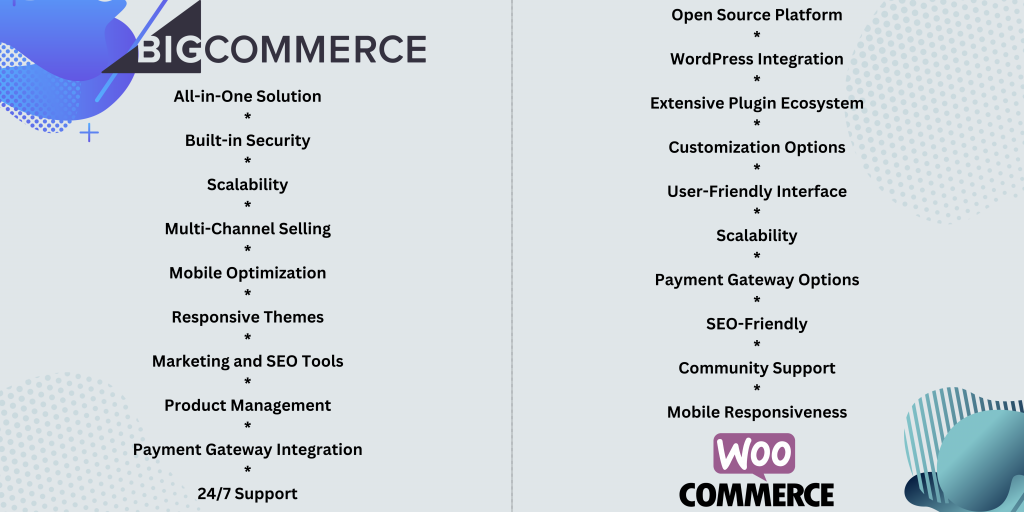Selecting the right ecommerce platform is a crucial decision for businesses, as it directly impacts their online presence, customer experience, and overall success. Two popular options in the market are WooCommerce and BigCommerce. In this article, we will delve into the features, potential flaws, and pricing structures of both platforms to help you make an informed decision based on your business needs.
What’s WooCommerce?
WooCommerce is a WordPress plugin that transforms a WordPress website into a powerful ecommerce platform. It is an open-source solution, offering flexibility and customization options. WooCommerce is known for its ease of use, making it a popular choice for businesses of all sizes.
The Most Prominent WooCommerce Features
- User-Friendly Interface
WooCommerce integrates seamlessly with WordPress, providing an intuitive and familiar interface for users. - Extensive Customization
As an open-source platform, WooCommerce allows for extensive customization, enabling businesses to tailor their online stores to specific requirements. - Wide Range of Plugins
The availability of numerous plugins allows users to add functionalities to their online stores, such as payment gateways, shipping options, and marketing tools. - Scalability
WooCommerce is suitable for businesses at various stages, from startups to large enterprises, offering scalability as business needs evolve. - Community Support
With a large and active user community, finding solutions to common issues or seeking advice is readily accessible.
Potential Flaws of WooCommerce
- Dependency on WordPress
Users must have a WordPress site to utilize WooCommerce, which may limit flexibility for those preferring alternative content management systems. - Self-hosting challenges
Managing hosting, security, and performance optimization falls on the user, requiring technical expertise or additional services.
When considering WooCommerce as your ecommerce platform, it’s essential to understand the intricacies of its pricing structure. While WooCommerce itself is free, businesses need to factor in several other elements to derive a comprehensive overview of their potential expenses.
WooCommerce pricing structure
WooCommerce itself is a free, open-source WordPress plugin, which means it doesn’t have a direct cost associated with its use. However, there are other essential components to consider when setting up an online store with WooCommerce. Here’s an overview of the key elements related to the pricing of a WooCommerce-based ecommerce site:
- WooCommerce plugin
The core WooCommerce plugin is free to download and use. It provides essential ecommerce functionality, such as product management, shopping cart, and checkout. - WordPress hjosting
Since WooCommerce is a WordPress plugin, you’ll need a WordPress website. The cost of hosting is a significant factor. Hosting services can range from shared hosting (more affordable but with limitations) to dedicated hosting (more expensive but with better performance). - Domain name
Purchasing a custom domain name (e.g., www.yourstore.com) is a common practice for branding purposes. The cost of a domain varies depending on the domain registrar and the chosen domain name. - Theme
While there are free WooCommerce-compatible themes available, some businesses prefer premium themes for a more polished and unique look. Premium themes can be one-time purchases or come with a subscription fee. - Extensions and plugins
To enhance the functionality of your online store, you might need additional WooCommerce extensions or plugins. Some are free, but premium plugins may have a one-time or subscription-based cost, like for SEO and accessibility. - SSL certificate
Ensuring secure transactions on your site is crucial. An SSL certificate encrypts data transmitted between your website and customers. SSL certificates can be free or involve an annual cost, depending on the level of security and the certificate provider. - Payment processing fees
Payment gateways often charge transaction fees for processing payments. WooCommerce supports various payment gateways, each with its own fee structure.
Key considerations:
- Variable costs
The primary variable costs for a WooCommerce site are hosting, domain, themes, and plugins/extensions. These costs can vary based on your choices and business requirements. - Scalability
The scalability of costs depends on the growth of your business. As your store expands, you might invest in more advanced hosting, additional premium plugins, or higher-tier themes. - Flexibility
The flexibility of WooCommerce allows you to control and customize your expenses based on your business needs and budget.
As you can see, while the WooCommerce plugin itself is free, the overall cost of running a WooCommerce store can vary widely based on your specific choices and business circumstances. Before making decisions, it’s advisable to assess your business requirements and budget constraints.

What’s BigCommerce?
BigCommerce is a fully hosted ecommerce platform, offering a comprehensive solution for businesses to create and manage their online stores. It caters to a wide range of industries and is designed to simplify the ecommerce process.
The Most prominent BigCommerce features
- All-in-One solution
BigCommerce provides hosting, security, and maintenance, offering a hassle-free, all-in-one ecommerce solution. - Scalability
Like WooCommerce, BigCommerce is scalable, accommodating businesses at different stages of growth. - Responsive themes
The platform offers a variety of responsive themes, ensuring a visually appealing and functional online store on various devices. - Built-in marketing tools
BigCommerce comes with built-in marketing tools, simplifying tasks such as SEO optimization, email marketing, and social media integration. - Multi-channel selling
BigCommerce allows businesses to sell on multiple channels, including Amazon, eBay, and social media platforms, expanding their reach.
Potential flaws of BigCommerce
- Transaction Fees: While BigCommerce doesn’t charge transaction fees, businesses using third-party payment gateways may incur additional fees.
- Learning Curve: Some users may find the platform’s interface initially complex, requiring time to adapt and fully utilize its features.
BigCommerce pricing structure
BigCommerce offers a tiered pricing structure that caters to businesses of different sizes and needs. The pricing plans are designed to provide flexibility and scalability. Here’s a brief overview of the typical features and pricing tiers:
- Standard plan
This is usually the entry-level plan suitable for small businesses or those just starting with ecommerce. It includes essential features such as unlimited products, storage, and bandwidth. Standard security and support are typically part of this plan. Transaction fees may apply, depending on the sales volume. - Plus plan
Geared towards growing businesses, the Plus plan includes additional features beyond the Standard plan. It may offer advanced analytics, abandoned cart saver functionality, and more. Reduced or no transaction fees could be included. - Pro plan
The Pro plan is often designed for larger businesses with more extensive needs. It includes all features from the Standard and Plus plans. Additional features may include Google customer reviews, product filtering, and advanced product search. Transaction fees are typically minimized or eliminated. - Enterprise plan
This plan is tailored for high-volume businesses and large enterprises. This plan is highly customizable and may include features like custom facets, price lists, and priority support. Enterprise plans are usually custom-priced based on the specific requirements of the business.
Key Considerations:
- Transaction Fees
Depending on the plan, BigCommerce may or may not charge additional transaction fees on top of the monthly subscription. Higher-tier plans often have reduced or no transaction fees. - Sales Volume
The pricing structure may also be influenced by the business’s annual sales volume. Some plans may have limitations on sales volume, while others are designed for unlimited growth. - Customization
The Enterprise plan offers the highest level of customization to meet the unique needs of large businesses.
It’s important to note that BigCommerce periodically updates its features and pricing, so it’s recommended to visit the official BigCommerce website or contact their sales team for the most current and specific information tailored to your business requirements.
WooCommerce vs BigCommerce: a head-to-head comparison
Choosing the right e-commerce platform is a pivotal decision that can significantly impact the success of your online business. BigCommerce and WooCommerce are two popular options, each with its own set of advantages. Let’s compare them head-to-head.
All-in-one solution and scalability
BigCommerce provides an all-in-one platform. It’s a comprehensive package that includes hosting, security, and a range of built-in features. This integrated approach simplifies the setup process and ongoing management, making it an attractive choice for businesses seeking a hassle-free experience. Besides, BigCommerce is a website builder.
Scalability is a key advantage of BigCommerce. The platform is designed to accommodate businesses of all sizes, handling high traffic volumes and extensive product catalogs without sacrificing performance. This scalability ensures that your online store can grow seamlessly with the evolving needs of your business.
WooCommerce, as a WordPress plugin, requires a separate hosting environment. While it offers flexibility, the setup may involve managing multiple components, potentially leading to a more complex configuration, especially for those new to WordPress.
Scalability with WooCommerce is achievable, but it might require careful consideration of the hosting provider and server resources. Large-scale operations may necessitate more strategic planning and potentially higher hosting costs.
Ease of use
BigCommerce is acclaimed for its user-friendly interface. The platform’s intuitive design makes it accessible to users with varying levels of technical expertise. The streamlined dashboard and straightforward navigation contribute to a positive user experience, allowing businesses to focus on their core operations.
WooCommerce’s ease of use is contingent on the familiarity with WordPress. Users experienced with WordPress may find it seamless, but those new to the platform might face a steeper learning curve. The complexity increases if extensive customization and plugin integrations are required.
Built-in features
BigCommerce comes with an array of built-in features, ranging from abandoned cart recovery to unlimited product listings. This abundance of functionalities reduces reliance on third-party plugins for essential e-commerce operations. The platform’s feature-rich nature is a significant advantage for businesses looking for a comprehensive solution.
WooCommerce is known for its extensive features, but some advanced functionalities may require third-party plugins. The extent of available features also depends on the chosen theme and additional plugins, potentially necessitating a more hands-on approach to feature integration.
BigCommerce Partner Program
One distinctive advantage of BigCommerce is its structured Partner Program. This initiative brings together agencies, developers, and technology providers in a collaborative ecosystem. Partners gain access to a variety of resources, including technical support, training, and co-marketing opportunities. The program empowers partners to deliver high-quality solutions to BigCommerce merchants, fostering a community of expertise and collaboration.
WooCommerce, being an open-source WordPress plugin, has a broad community of developers and contributors. While it lacks a structured partner program comparable to BigCommerce, the community-driven nature means businesses can find support and resources through forums, documentation, and various online communities. However, the level of collaboration and support can vary based on individual partnerships within the ecosystem.
Security and compliance
Security is a top priority for BigCommerce. The platform includes built-in security features, and it is PCI DSS compliant. This compliance ensures that payment information is handled securely, providing peace of mind for both merchants and customers.
WooCommerce: WooCommerce maintains security through adherence to WordPress best practices and secure hosting. While it follows industry-standard security measures, maintaining compliance may require additional efforts, and businesses must ensure their hosting environment meets necessary security standards.
Exploring the differences: comparing BigCommerce vs WooCommerce vs Shopify
Embarking on the journey of establishing an online store requires a careful examination of the available ecommerce platforms. Let’s look at WooCommerce and BigCommerce compared to the industry giant and most popular ecommerce platform, Shopify.
Brief overview of the platform
As one of the leading ecommerce platforms, Shopify has gained immense popularity for its user-friendly interface and comprehensive set of features. It is an all-in-one solution that caters to businesses of all sizes, from startups to enterprises. Shopify streamlines the process of setting up and managing an online store, making it an attractive choice for those seeking simplicity and efficiency.
Buisness management big capabilities
Shopify posesses some exclusive features making it stand out as an ecommerce platform. Let’s break them down.
- Shopify Payments
Shopify Payments is Shopify’s proprietary payment gateway. Seamlessly integrated into the platform, it simplifies the payment process for merchants by eliminating the need for third-party payment processors. - Shopify App store
The Shopify App Store is a powerhouse of exclusive apps and plugins curated specifically for Shopify users. Merchants can access a vast array of tools to enhance their store functionality, ranging from marketing automation to shipping and fulfillment solutions. - Shopify Plus for enterprise-level scalability
Shopify Plus is an enterprise-level solution designed for high-growth businesses. It provides exclusive features, such as advanced customization options, dedicated account management, and API support, ensuring scalability for large and complex operations. - Shopify Flow for automation
Shopify Flow is an automation tool that enables merchants to streamline repetitive tasks. It’s an exclusive feature that allows businesses to automate workflows, saving time and resources. - Shopify Experts Network
The Shopify Experts Network connects merchants with certified professionals for various services, including design, development, and marketing. This exclusive network ensures that businesses have access to skilled experts for specialized needs. - Merchant Success Program
For businesses on Shopify Plus, the Merchant Success Program offers exclusive resources and support. This program includes strategic guidance, training, and access to exclusive events, enhancing the overall experience for high-level merchants.
Why some businesses prefer WooCommerce or BigCommerce
While Shopify offers a robust set of features, there are instances where businesses may opt for WooCommerce or BigCommerce instead.
- Customization and flexibility
Powered by WordPress, WooCommerce offers unparalleled customization and flexibility. Businesses that prioritize a high degree of control over their online store’s design and functionality may prefer the extensive customization options provided by WooCommerce.
With a focus on scalability and flexibility, BigCommerce caters to businesses with unique customization requirements. Its open API architecture allows for extensive integrations and customizations, making it a strong choice for businesses with specific needs. - Cost considerations
Both WooCommerce and BigCommerce can be cost-effective options for businesses, especially those conscious of budget constraints. WooCommerce is an open-source plugin with no licensing fees, while BigCommerce offers a variety of plans tailored to different business sizes. - Ownership and control
Being a self-hosted solution, WooCommerce provides businesses with complete ownership and control over their online store. This level of control is appealing to businesses wanting to manage their hosting environment.
While not self-hosted, BigCommerce strikes a balance by offering a hosted solution with a high degree of customization. It provides the benefits of a fully hosted platform while allowing businesses to tailor their online store to specific requirements.
Factors to consider when choosing an ecommerce platform
As previously mentiones, selecting the right ecommerce platform is a critical decision for any business, impacting its online presence, customer experience, and overall success. With such a variety of options available on the market, choosing the right ecommerce platform for your buisness might be challenging. Even if you’re comparing two solutions, there are several factors to consider, each playing a crucial role in determining the suitability of a platform for your unique business needs.
Business size and growth
Understanding the current size of your business and anticipating its growth is fundamental when choosing an ecommerce platform. Some platforms are better suited for small businesses, while others offer scalability for enterprise-level operations. Assess your business trajectory to ensure the selected platform can grow with you, accommodating increased product listings, traffic, and transactions.
Budget
Evaluating the budget is a crucial step in the decision-making process. The cost of ownership extends beyond the initial setup and may include hosting, plugins, and additional features. Carefully examine the pricing structure of each platform and consider any potential hidden costs. Aligning the platform’s expenses with your budgetary constraints is essential for long-term sustainability.
Technical expertise
Assess the technical capabilities of your team when considering ecommerce platforms. Some platforms are user-friendly with intuitive interfaces, making them suitable for businesses with limited technical expertise. On the other hand, self-hosted solutions might require a higher level of technical know-how for setup, maintenance, and customization. Choose a platform that aligns with your team’s skills or be prepared to invest in training.
Feature requirements
Identify the specific features that are crucial to your business operations. Different ecommerce platforms offer varying capabilities, such as support for specific payment gateways, inventory management, or multi-channel selling. Create a comprehensive list of features your business requires and compare them against the offerings of each platform to find the best match.
User-friendliness
User-friendliness is paramount for both administrators managing the online store and customers navigating the site. An intuitive and easy-to-use platform can streamline daily operations, reducing the learning curve for your team. Additionally, a user-friendly interface enhances the overall shopping experience for customers, contributing to higher satisfaction and potentially increased conversions.
Word of mouth
When choosing an ecommerce platform, you can’t ignore word of mouth, as it encapsulates the collective sentiment, recommendations, and experiences shared by businesses within the community. This informal communication, disseminated through reviews, testimonials, online discussions, and industry influencers, serves as a crucial factor in decision-making. Positive word of mouth signifies a platform’s credibility, user satisfaction, and long-term viability, offering insights into real-world success stories and problem resolution capabilities. By considering the reputation, peer recommendations, and feedback from diverse sources, businesses can gain a comprehensive understanding of how an ecommerce platform aligns with their specific needs and industry requirements, facilitating a more informed and confident choice.
Conclusion
The choice of an ecommerce platform is a multifaceted decision that requires careful consideration of various factors.
One might want to consider the different mechanisms for setting prices and weigh the overall value against costs. While some platforms may seem enticing at first glance, it’s crucial to assess the long-term implications, especially when faced with scenarios like twice the cost comparisons between platforms such as BigCommerce vs Shopify or WooCommerce vs Magento.
For businesses leveraging a WordPress site, exploring the extensive WooCommerce features can offer tailored solutions, while those seeking a comprehensive, all-in-one approach may find the integrated BigCommerce platform advantageous. The importance of a robust credit and credit card processing system cannot be overstated, and platforms like BigCommerce prioritize secure transactions and seamless payment processing. Engaging with the BigCommerce Partner program further opens avenues for collaboration and expertise, ensuring businesses can harness the full spectrum of features BigCommerce offers.
So again, in navigating the nuanced landscape of ecommerce, an informed choice involves a holistic consideration of features, pricing, and support to align with the unique needs of each business.

.png)




